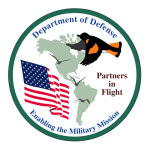Partners in Flight was initiated in 1990 to help stem and reverse the declines in populations of neotropical/nearctic migratory birds. These are birds that breed in the United States and Canada, but spend the winter months in the tropical regions of Latin America. The Sikes Act Improvement Act of 1997 includes several changes that link the goals and objectives of natural resources planning on DoD installations with those of the Partners in Flight bird conservation strategy. Specifically, Integrated Natural Resources Management Plans (INRMP) must now be completed, and must be integrated through ecosystem management practices that include large-scale, landscape-level goals that reach beyond installation boundaries. The plans also must address non- consumptive use of wildlife, such as embodied in Watchable Wildlife programs, and must be completed with review by state and federal agencies. Partnerships are encouraged in order to maximize efficient use of limited management (human and financial) resources.
Partners in Flight bird conservation plans identify species and habitats most in need of conservation, and establish objectives for bird populations and habitats in physiographic areas (ecoregions) and states. The plans not only identify the microhabitat requirements of priority species, but also focus on the types and quality of habitats required by birds at the landscape scale. Conservation recommendations are developed and partnerships are formed to accomplish them in the same way other INRMP projects are implemented. Information and recommendations in the plans are based upon sound science and consensus among interested groups and knowledgeable individuals. The goal of the North American Bird Conservation Initiative (NABCI) is to deliver bird conservation through a “vision of regionally-based, biologically-driven, landscape-oriented partnerships delivering the full spectrum of bird conservation across the entirety of the North American continent.” It will integrate the Flight Plan with international planning efforts for waterfowl, shorebirds, and colonial waterbirds into structures analogous to existing North American Waterfowl Management Plan Joint Ventures. The resulting entities will manage all birds in all habitats.
Including a Partners in Flight component (a bird conservation plan) within an INRMP is a natural and logical extension of the INRMP. We offer recommendations on how to incorporate the goals and objectives of the Flight Plan into an installation’s INRMP. In addition, implementing conservation measures can help minimize and mitigate potential impacts to migratory birds.

